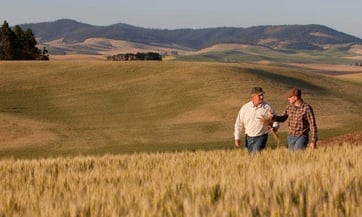
Our experts and industry insiders blog the latest news, studies and current events from inside the credit card industry. Our articles follow strict editorial guidelines.
In a Nutshell: Farmers face unique challenges in running their farms and managing their businesses. AgAmerica understands the agriculture business and provides farmers with access to financing products to help farms thrive. The company works with financially distressed farmers to fix their cash flow problems and restore the health of their farming business. AgAmerica provides estate and succession planning services to help farmers ensure their farm’s future is bright.
Americans owe a debt of gratitude to United States farmers who work throughout the year to produce nourishing and delicious crops. The produce that farmers grow also brings visual appeal to meals. The bright yellows of corn and the deep reds of fresh strawberries can illuminate color-starved spreads.
The food grown on farms also ties into elements of Americana. Halloween wouldn’t be quite the same without pumpkins. A slice or two of watermelon can make a sunny summer day even better.
AgAmerica is an agricultural lender that originates loans across the U.S. It operates in all 50 states, and its products include both conventional and nonconventional loans.

We spoke with Curt Covington, AgAmerica’s Senior Director of Institutional Credit, to learn more about the American farming business and AgAmerica’s work to support farms.
“The agricultural space had a pretty good run in 2021 and 2022,” Covington said. “Farm revenues were doing well, and expenses were fairly moderate. But near the end of 2022, farmers’ input costs rose significantly, including costs for fertilizer, farming chemicals, labor, and interest rate expenses. In 2023, farm revenues have generally come off a bit from their highs.”
Covington said the costs of fertilizer and various fuel-based chemicals have stabilized, but other costs are still increasing, including labor and interest rate expenses.
Several regulators govern banks, including the FDIC, the Office of the Comptroller of the Currency, and various state banking regulators. The Farm Credit Administration regulates the Farm Credit System, but AgAmerica is a nonbank agricultural land lender registered with the SEC as an investment advisor firm.
Covington said AgAmerica’s status provides it with flexibility. AgAmerica raises capital and lends it into the market in accordance with its lending guidelines.
“AgAmerica can do deals that other lenders can’t do because their regulatory environment prevents them from doing so,” Covington said. “We have the ability to provide a lot of flexibility, particularly if a borrower is in distress. Oftentimes, when a distressed borrower goes to the bank or another lending institution for assistance, the bank will just close the door on them.”
Rising Costs Pose Challenges for Farmers
Agricultural lending activity is on the rise in the U.S., and Covington said a couple of factors can explain why farmers are increasingly seeking loans.
Farmers are in a more difficult financial situation than they were just a few years ago. Their liquidity and working capital positions have declined.
“In my 45 years in this business, I haven’t seen a situation like this where interest rates for many agricultural businesses have tripled,” Covington explained. “In some cases, interest rates have even quadrupled. Meanwhile, land values, which historically are closely tied to interest rates, have not moderated much. Land values are continuing to climb but at a decreasing rate. Land is the primary collateral we use to provide additional liquidity to agricultural borrowers.”

AgAmerica helps borrowers restructure their balance sheets and offers them a variety of loan products. Covington said AgAmerica’s 30-year conventional fully-amortized loans are similar in structure to home loans. It also offers term loans that can help farmers experiencing cash flow problems.
“We have a robust set of products that can help distressed farmers,” Covington said. “Our whole purpose is to make loans to distressed borrowers so they can get back into a conventional borrowing relationship after their period of distress has passed.”
Covington said numerous factors can cause a borrower to experience cash flow problems. Some of those factors are out of the borrower’s control, including weather-related challenges or a death in the farmer’s family that has created potential tax-related issues.
AgAmerica works with its clients to understand their unique problems and concerns, and the company builds a financing package to comprehensively address customer needs .
“We work with the borrower on a regular basis to make sure they continue on the right path,” Covington said. “And we’ll give them whatever guidance and support they need.”
Consolidation is Changing the Agricultural Business
As with many industries, the business practices around agriculture have changed over time to adapt to market conditions. Covington said the farming industry has had to adapt to significant changes in recent years.
Farm business partners are rapidly consolidating their operations. Covington said economies of scale have motivated agricultural supply companies to consolidate. Most farmers rely on outside companies to supply fertilizer, chemicals, and farming equipment. The stores to whom farmers sell their goods have also been consolidating, leaving farmers with fewer business partners to work with.
“The last bastion of unconsolidated business in the United States is the family farmer,” Covington said. “That’s not to say we’re not seeing any consolidation among farmers, especially as expenses rise, but our goal is to preserve the family farm.”
AgAmerica offers services to help farmers with estate planning and succession management. Covington said many farmers are nearing retirement age and are looking to transition their business to their children. Transferring a farming business from one party to another is a complicated process that requires careful planning and tax considerations.

“When farming families are considering succession planning, AgAmerica can step in and help them plan and guide them through the process with our financing packages,” Covington said.
Covington, who grew up on a farm, said farmers today need to keep a close eye on the business aspect of farming to position themselves for success. In particular, farmers need to be skillful when marketing their crops.
“When I was a kid, we’d do a great job growing our crops,” Covington said. “We’d send our crops to the packing house. Then they’d be sold, and we’d get our money. Farming doesn’t work that way anymore. Farmers are having to become more sophisticated in marketing their crops. They have to spend a good portion of their time deciding how they will market their crop to improve their margins.”
AgAmerica Prides Itself on Educating Farmers
Covington said other industries have evolved to incorporate new technologies that streamline their processes and reduce costs, but the farming industry has had a different experience.
“We’re just getting to the point where major technology companies are really working hard to help farmers reduce their costs,” Covington said. “Today, strawberries, table grapes, citrus fruits, and vegetables are all picked by hand. But, in another 10 years, you’ll see that most of these crops are not going to require manual labor. They’re all going to be harvested by machines.”
Covington said the next generation of students enrolled in agricultural colleges are being taught the importance of agricultural technology and improving the efficiency of farming operations.
“But new farming technologies are really expensive, and many farmers will need to borrow to finance their operations,” Covington added.
AgAmerica prides itself on educating farmers on the money management skills required to succeed in the agricultural business. AgAmerica dedicates a portion of its website to providing insights on the agricultural industry. The company’s financial health check tool helps farmers assess their business’s financial position.
“We regularly consult with our clients,” Covington said. “The free advice we provide comes from what we’ve learned working with other farmers throughout the years and seeing what works and what doesn’t work.”


![7 Best Credit Cards for Farmers ([updated_month_year]) 7 Best Credit Cards for Farmers ([updated_month_year])](https://www.cardrates.com/images/uploads/2023/10/Best-Credit-Cards-for-Farmers.jpg?width=158&height=120&fit=crop)

![What Is Netspend? The Company & Its Products ([updated_month_year]) What Is Netspend? The Company & Its Products ([updated_month_year])](https://www.cardrates.com/images/uploads/2022/10/What-Is-Netspend.jpg?width=158&height=120&fit=crop)
![5 Best Bank of America Cash Back Credit Cards ([updated_month_year]) 5 Best Bank of America Cash Back Credit Cards ([updated_month_year])](https://www.cardrates.com/images/uploads/2023/01/Bank-of-America-Cash-Back-Credit-Cards.jpg?width=158&height=120&fit=crop)
![3 Best Bank of America Credit Cards for Travel ([updated_month_year]) 3 Best Bank of America Credit Cards for Travel ([updated_month_year])](https://www.cardrates.com/images/uploads/2023/03/Best-Bank-of-America-Credit-Cards-For-Travel.jpg?width=158&height=120&fit=crop)
![12 Bank of America Credit Card Limits ([updated_month_year]) 12 Bank of America Credit Card Limits ([updated_month_year])](https://www.cardrates.com/images/uploads/2023/04/Bank-of-America-Credit-Card-Limits.jpg?width=158&height=120&fit=crop)
![5 Bank of America Contactless Credit Cards ([updated_month_year]) 5 Bank of America Contactless Credit Cards ([updated_month_year])](https://www.cardrates.com/images/uploads/2023/05/Bank-of-America-Contactless-Credit-Cards.jpg?width=158&height=120&fit=crop)
![Average Credit Card Debt in America in [current_year] Average Credit Card Debt in America in [current_year]](https://www.cardrates.com/images/uploads/2023/06/CR-AverageCreditCardDebtInAmerica-1250X650.jpg?width=158&height=120&fit=crop)